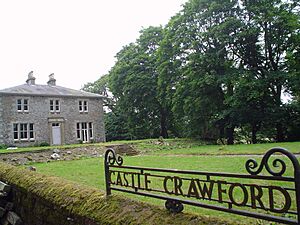Crawford Castle facts for kids
Crawford Castle is an old castle, mostly in ruins today. You can find it on the north bank of the River Clyde in South Lanarkshire, Scotland. It's about half a mile north of the village of Crawford. This castle was built on an even older earthwork called a motte and bailey. It used to be known as Lindsay Tower, named after the Lindsay family who owned it for a long time. The castle's location was very important because it guarded the Mennock Pass, a key route from England into the upper Clyde Valley.
Contents
History of Crawford Castle
Ancient Roman Fort at Crawford
Did you know that before the castle, a Roman fort stood on this very spot? Archaeologists have found evidence that a Roman fort, possibly holding about 300 soldiers, was here between 80 AD and 170 AD.
Early Days of the Barony
This area was once the main center for the Barony of Crawford. This was a very large and powerful area in southern Scotland. The Barony was set up before 1100. Records show that Thorlongus of the Merse was the first "Overlord" of Crawford. The Crawford family came from this line and were the first people to live in the barony. Crawford Castle itself was already built by 1175. It was probably first made of earth and wood by the Crawford family even earlier.
The Lindsay and Carmichael Families
In 1215, the Lindsay family gained half of the Barony of Crawford, known as Crawford Parish. This happened through a marriage to the younger daughter of Sir John Crawford. The Crawford family kept the other half, called Crawfordjohn Parish. Crawford Castle is located in Crawford Parish. For a long time, the Clan Carmichael of Meadowflat family served as the castle's hereditary constables. This meant they were in charge of looking after the castle for its owners.
A Famous Duel and New Owners
In 1398, King Robert II gave the title of Earl of Crawford to David Lindsay. David was famous for his bravery! On April 23, 1390, he won a duel against an Englishman named Baron Welles on London Bridge. This duel happened after Baron Welles, at a banquet in Edinburgh, challenged any Scottish knight to a fight.
When King James IV came to power in 1488, the Barony of Crawford was given to Archibald Douglas, 5th Earl of Angus. This was because he had supported James IV's father, James III, against the young prince's rebellion. The Earls of Angus owned the castle until 1578.
Royal Hunting Lodge and Later Owners
The young King James V took control of the castle in 1578. He used Crawford Castle as a hunting lodge until he died in 1542.
After 1542, the castle returned to the Earls of Angus. The Carmichael family stopped being the castle's keepers in 1595. In 1633, the 11th Earl of Angus became the Marquess of Douglas. The castle was likely rebuilt around this time. Later, the castle passed to the Duke of Hamilton. In the 18th century, it was sold to Sir George Colebrooke.
The castle was then used as a farmhouse for a while. But by the end of the 18th century, it was left empty. Much of its stone was used to build the nearby Crawford Castle Farm that you can see today. You can still see four stone tablets with family symbols, one dated 1648, built into the walls of Castle Crawford House.
What Remains of Crawford Castle Today
The earliest parts of Crawford Castle are its earthworks. These include a motte, which is a mound of earth about 5 meters high. It has a ditch around it and a bailey, which is a flat area about 45 meters by 33 meters, to the south-west.
On top of the motte, you can see the remains of a curtain wall. This wall surrounded an area about 20 meters square. There might have been round towers at the corners of this area. These parts probably date back to the 16th or early 17th centuries.
A group of buildings on the south-west side of the castle were built around the same time. This part was like a tower with three floors, plus an attic. It had a vaulted basement and a chimney that stuck out. Later, in the 17th century, another group of buildings was added to the south-east. These had bigger windows and offered more comfortable living spaces.
The large arched area in the east wall suggests that a single-story building once extended from the main castle here. Most of what you see today probably comes from the rebuilding done by the Marquess of Douglas in the 17th century.
Crawford Castle is now a Scheduled Ancient Monument. This means it's a very important historical site protected by the government. The Royal Commission on the Ancient and Historical Monuments of Scotland also lists it as a significant castle or motte site.



